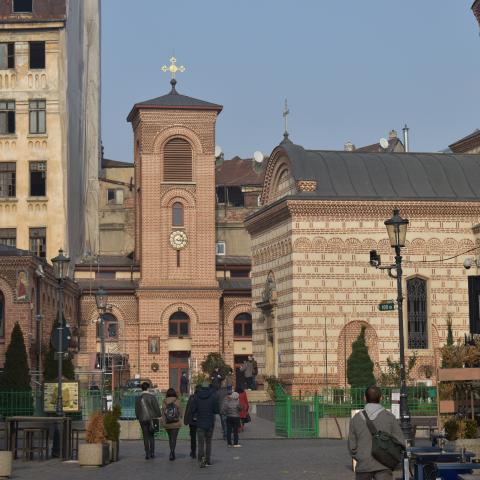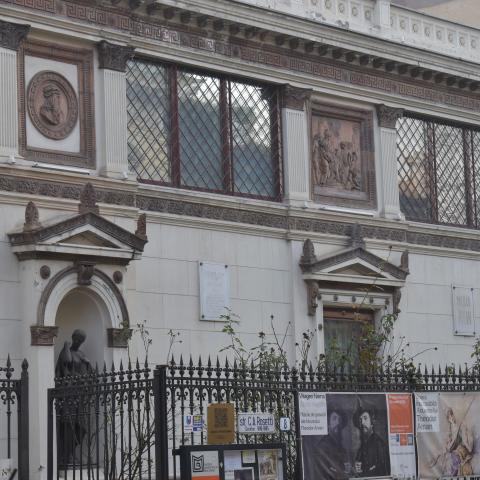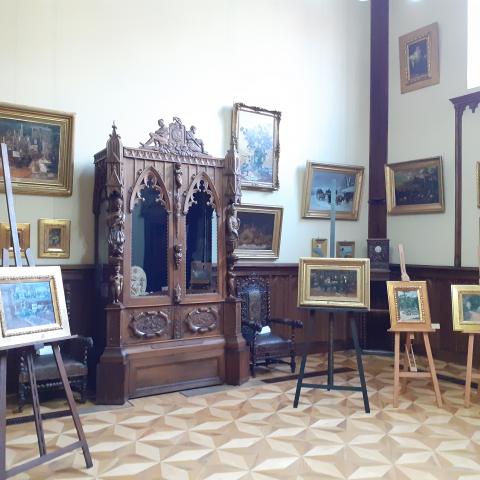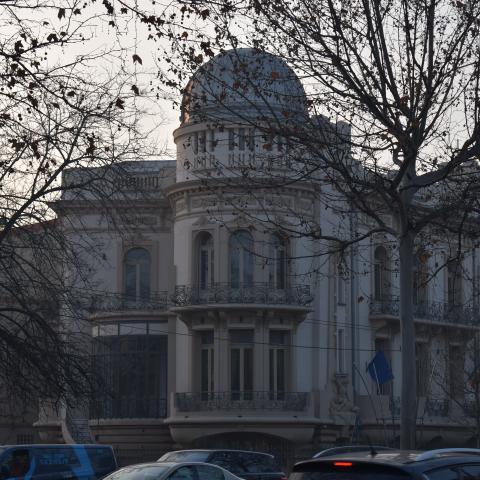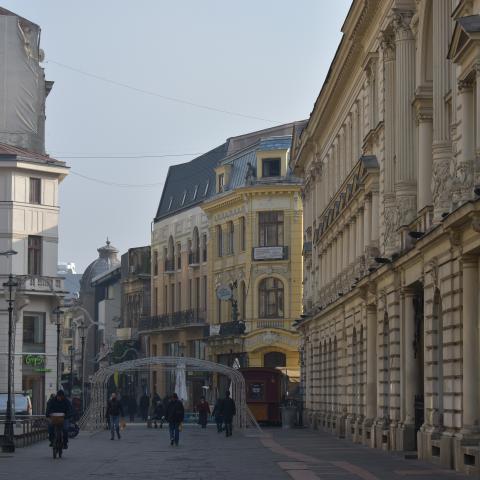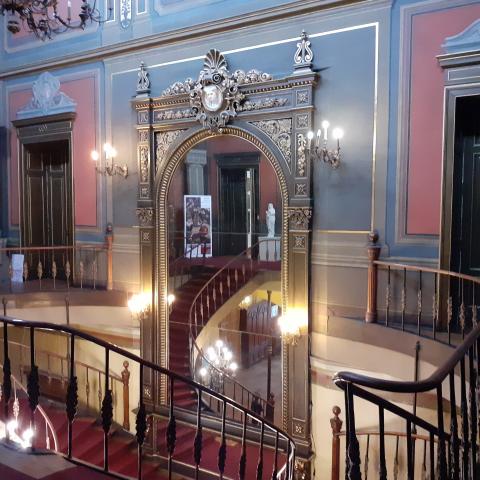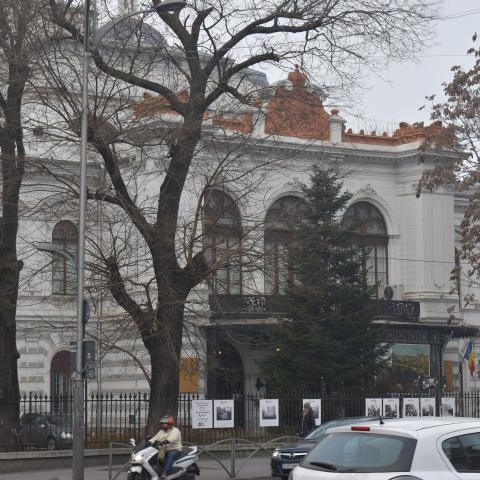"Destination: Bucharest" - A visit to the Bucharest Municipality Museum
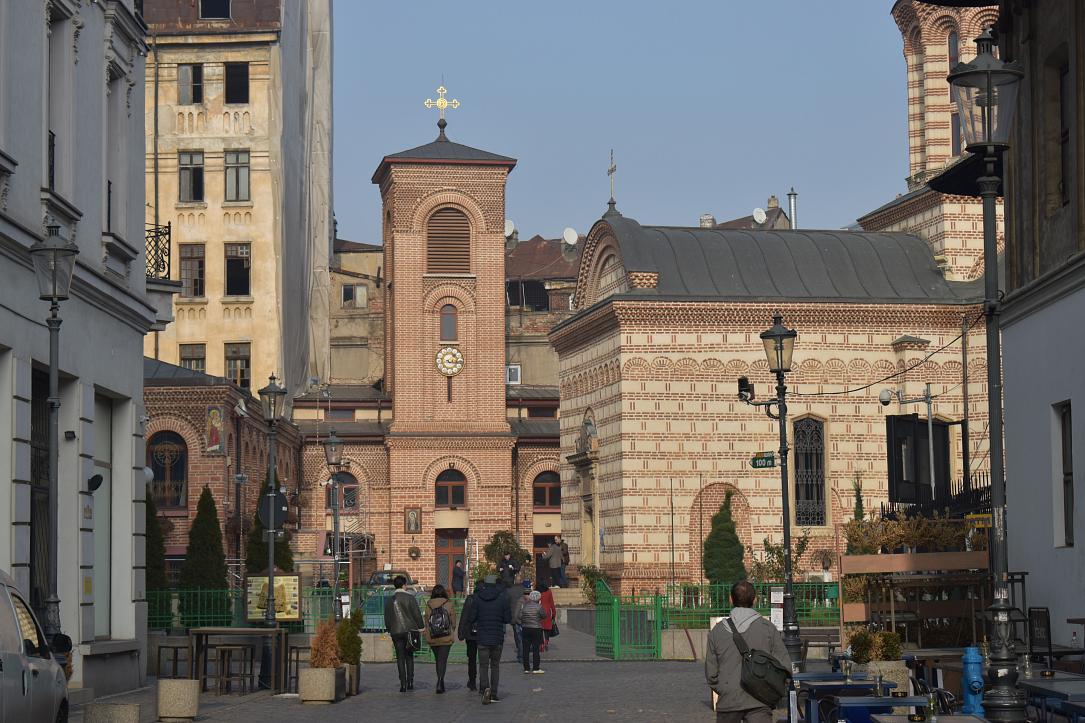
At the beginning of the year, we visit several of the museums that preserve the past and the histories of the city: we hear singer Maria Tănase over the phone, get acquainted to Bucharest as seen by painter Theodor Aman and take a walk among the stars under which the city falls asleep every night.
It is a cold January morning. The fog has not completely lifted yet and the forenoon agitation fills the Universitate roundabout: students are on their way to classes, couriers are cycling their way through the traffic, while others are waiting for the express bus line going to the airport. On one side, at the intersection of the Regina Elisabeta and I. C. Brătianu boulevards, the Suțu Palace lifts its laced rooftop towards the grey sky and its two side gates are open, waiting for visitors to come in.
One of the oldest aristocratic residences in Bucharest, the Suţu Palace was built by Costache Suţu, between 1833 and 1835. The plans were drawn by architects Conrad Schwink and Johann Veit, while the interior was designed in 1862 by sculptor and artist Karl Storck. It was built in the Neo-Gothic style, even more impressive given that, at that time, the city was rather modest-looking, the buildings with more than one level were relatively few and the streets were paved with wood.
The building knew its heyday throughout the second half of the 19th century, when it used to host the first society ball of every year, in February. The hosts were Grigore Suţu and his wife Irina, who used to welcome the Bucharest high-life into their residence. The gates of the edifice are decorated with two reproductions after the heraldry of the palace: the sun supported by two lions. At the time of the two, flames burnt from around the sun, quite the sight for the city of that period and a symbol of the status of the owners. The garden of the palace, bigger than it is today, was also impressive, with lush vegetation.
As soon as we enter, the impressive hallway catches our attention: the tall mirror brought from Murano, with a frame where a wood-sculpted medallion representing Irina Suţu stands out. From the opposite wall, one of the symbols of the palace mirrors in – the clock that runs backwards. The clock was designed to be read in a mirror and was manufactured in Paris.
We climb the stairs and arrive in the area where, in the past, the guests would have been received by the hosts, and where several statues representing the seasons of the year or a Roman female character are on display.
Just as the clock goes backwards, the exhibition we are about to enter – “The Time of the City” – presents in reverse chronology, from the present to the past, the events, the day-to-day and the trials the city has gone through. Symbolically, it opens with a small display of richly ornate table clocks. In a separate room we watch a short film, screened so as to give the impression that we watch, through the windows of the palace, at a fast pace, the main events of the transition period, from the 1989 Revolution to the present, going through episodes such as Michael Jackson’s Bucharest concert, street demonstrations, elections, the visits of US presidents or the NATO accession.
Afterwards, we enter the exhibition with a first stop at the communist period, covered with its major symbols and stages. For instance, the People’s Palace, which has become a tourist attraction, built after the demolition of the Uranus neighborhood, one of the Capital’s oldest and most beautiful. The panels, with explanations in both Romanian and English, present the mechanisms of the propaganda, the idea of “the new man”, the social life during Communism, the 1977 earthquake and many more. Next to them, various items belonging to the private sphere, banknotes, registration and ID cards are exhibited.
As we make our way through the exhibition, we leave behind the Communist period to arrive to that of the monarchy, in an area where the busts of kings Carol I and Ferdinand are also exhibited. We are getting close to the period of the First World War, when the Suţu Palace served as the residence of the German governor of the occupied Bucharest - general Tülff von Tschepe und Weidenbach. We also get to discover the female fashion of the time, and the accessories worn by the ladies, but also weapons, medals, interior décor items, alongside drawings and photos that give us some clues as to what the city used to look like.
We advance through the Belle Epoque Bucharest, on the streets of which velocipedes would run – one is on display at the palace, next to explanations about how the city was transforming at the time, from the street lighting to the paving of the Podul Mogoșoaiei artery.
We continue our travel through the past and we discover, with the help of the exhibited images, a Bucharest of water carriers, of petrol sellers, of street vendors, of inns and of the mills on the Dâmbovița river. We get see what the Moșilor fair looked like, or the streets and buildings we pass by today without thinking too much about the years they carry - Calea Victoriei, Sfântul Anton Square, the North Railway Station, Boulevard Hotel, the Post Palace, the Royal Palace or the Lazăr High School. In another display case we see a few items that speak of the private life at the time: a small flatiron, a lace kit, and a travel-size sewing machine.
We advance past a section providing details about the călărași cavalry division and we find on display a beam from the Podul Mogoșoaiei road, as today’s Calea Victoriei used to be called, reminding us of the pavement system of the streets. Under the wood pavement, dirt and mud would often accumulate. It is not the image of the most elegant city, and the exhibits nearby – a velvet dress and kaftan, elaborately embroidered – invite us to ponder the contrast between the city’s state and the sumptuous clothing of some of its inhabitants. In the same room, we discover a parade sword of ruler Constantin Brâncoveanu and his portrait, as well as a portrait of ruler Vlad Țepeș.
Bit by bit, we have made out way to the area where some of the oldest items discovered on the territory of or around Bucharest are exhibited: weapons, tools, pots. One of the most interesting exhibits is the Goddess of Vidra or the Venus of Vidra. Belonging to the Gumelnița culture, it is a feminine statue-vase, with a massive lower half, suggesting fertility.
We exit the “Time of the City” exhibition and we go to see some of the works of the Bucharest Pinacotheque. The exhibition “Still Life, Alive Nature (Masterpieces from the Collection of the Bucharest Pinacotheque)” is currently open. It covers works by Nicolae Grigorescu, Ştefan Luchian, Constantin Artachino, Theodor Pallady, Gheorghe Petraşcu, Ştefan Popescu, Elena Popea, Cecilia Cuţescu Storck and others.
We return to the ground floor and discover more exhibitions. One is dedicated to a part of the city’s and the country’s recent past – the December 1989 Revolution and the Communist period, looking at the personality cult of dictator Nicolae Ceaușescu.
In the hallway, we stop to watch a documentary film about Queen Marie of Romania, part of the Cinema Museicon project. The documentary is part of the series “Women in War and Peace in the Decade of the Great Union”, and proves another opportunity to learn more about the national and local history.
Another exhibition area is dedicated to the Văcărești Monastery. Built in the Brâncovenesc style, between 1716 and 1736, this architectural ensemble was one of the most valuable historical monuments in the city. It was demolished in 1986, at the order of Nicolae Ceaușescu. Now, the exhibition “The Memory of Architecture: The Testimonies of Architects on the Văcărești Monastery” offers the public the opportunity to see fresco fragments from the church of the monastery.
Another area, dedicated to the exhibition “People of Bucharest. The City and our Face,” gets us acquainted to the people who lived in the city from the 18th century to the present, with the help of numerous paintings, photos, lithographs or numismatic exhibits. In a dedicated space, a bust of ruler Mihai Viteazul (Michael the Brave) catches our eye. The work of sculptor Radu Tudor Panait, it is the result of a facial reconstruction project, after the photographs and measurements of the ruler’s skull taken in 1920 in Iaşi, at the request of the Army, by Francisc Rainer, who is considered the parent of anthropology in the country.
In between other exhibits we see two black, old phones, with a rotary dial. We get closer to take a look, drawn by the sound of music playing at a low volume. We lift the receiver and, to our surprise, we get to listen to Maria Tănase sing. On the other phone we listen to Constantin Tănase, the Romanian vaudeville actor. The past sound of the city and its people is closer to us than we expected.
From the Suțu Palace, we cross the Old Town, past the future location of the Bucharest Pinacotheque – the Dacia Palace, make our way onto Calea Victoriei and after a short stroll we arrive at the Theodor Aman Museum. At the entrance, the maestro himself welcomes us with a virtual greeting and an invitation to keep the memory of the encounter as a photo – a selfie with the artist. What we are seeing is an augmented live video solution, with a similar project developed at the Suțu Palace, where the represented character is Irina Suțu.
We enter one of the most beautiful private residences in the city, the first house-studio of an artist in the country. The villa, which stands next to the Central University Library, was built in 1868, according to the project of painter Theodor Aman, the owner of the house, and very little changes were brought to it in time. The artist left his mark in a multitude of aspects related to the residence, such as the exterior decoration, done in collaboration with sculptor Karl Storck, the mural painting, the stained glass work, the decorations painted on the woodwork or the ceilings’ stucco work.
The house became a museum in 1908, after the artist’s wife arranged the donation to the Romanian state. It is one of the oldest memorial museums in the country and a must-see destination not only for the artist’s works but also for the way it offers a testimony of the city’s Belle Epoque atmosphere.
We enter the salon, the largest room in the museum, and we immediately find ourselves in the universe of Aman. The interior mirrors the painter’s studio scenes painted by Aman, a theme he tackled several times, in different paintings which show various canvases from his studio. We find a painter’s studio scene displayed on one of the easels in the room. Another work, a self-portrait, shows Aman painting, while another canvas shows the painter in his studio, working while his brothers sit close by – an opportunity to compare past and present, the image and the represented interior.
The silence in the room is briefly interrupted by the first sounds of Bach’s well-known Cello Suite No.1. We discover in a corner Aman’s cello, also represented in the studio scene on display nearby. Aman learned to play the cello as a child and kept his passion for music throughout his life. His house used to host concerts that were famous at the time, attended by the city’s high society. People came for the concerts but they could also admire the artist’s works and those interested could purchase them.
Another painting by Aman shows his wife, Ana Aman, looking out on the window from their home, an opportunity to see the Bucharest of that time represented in a painting, a city yet untransformed by the French architectural influence. Aman’s works can also be seen as a visual chronicle of his time. The artist, who co-founded in 1864 the first Romanian fine arts school in Bucharest, painted numerous scenes depicting his contemporaries – parties with folk musicians, society balls, rural scenes, and the characters populating them give us an image of those times, with its ladies in the elegant dresses of the Belle Epoque fashion, with elaborate hats, and the gentlemen wearing suits and lavalliere ties.
A temporary exhibition hosted by the museum lets the public discover the engraving plates made by Aman. The artist learned the technique during his studies in Paris. The engraver uses a needle to scratch the varnish layer covering the engraving negative and the paper image is obtained as the metal negative goes through the engraving press. The Aman Museum also hosts the engraving press the artist brought from Paris, and visitors can also watch a short film detailing how engravings are produced.
We say goodbye, alongside a lady who has just purchased an album about Aman and another who confesses to be very impressed by the engraving negatives display and promises to return. We head towards Romană Square, enter Lascăr Catargiu boulevard and arrive at the Admiral Vasile Urseanu Astronomical Observatory.
Recently refurbished, it is housed in the villa built by admiral Vasile Urseanu. It is the only astronomical observatory in the city that is open to the public and the history of the institution dates back to 1908, the year the admiral became the president of the Romanian Astronomical Society.
The admiral financed the construction, which was to serve as his residence and from where he could undertake observations, with a telescope he offered to the observatory - a Zeiss one with a 150 mm lens. After the admiral passed away, his wife donated the building to the city, according to the admiral’s wish, in order for it to be preserved as a reminder of his accomplishments in the field of astronomy.
We meet the admiral right at the entrance, with the help of a short film, screened in the hallway of the building. In the video, the admiral is recounting his career and his passion for astronomy. Before going up to the second floor, where the permanent exhibition is set up, we take a look at the colorful stained glass depicting the sun and various planets, at the old telescope, sitting next to the spiraling wooden staircase. We are ready for a visit among the stars, from where we will find, from the various displays, many things about the solar system, the place of the Earth in the Universe, the stars and the galaxies.
How does Earth compare to other planets? What is the age of the Universe? What is there beyond the Earth’s atmosphere? What were the missions that explored the solar system? What does the Sun look like through a telescope? What are the asteroids carrying Romanian names and what are the rules by which these are named? What does a cloud map look like? How do stars appear? How much noise do we project in space? These are just some of the questions we find answers to in the exhibition.
We go up to the next level, on the terrace, to see if solar observations can be made. Unfortunately, the day is not clear enough for it, but we are told what we would have seen and we are invited to attend the evening observations. We leavewith the image of the city seen from up above: the rooftops of the historic villas, church towers, next to recently built office buildings upon which the evening will soon fall. The recent and more distant past blend in the urban texture, adding another bit to the history of the city, which we might see preserved, in the future, in a museum in Bucharest.
Addresses:
Suțu Palace - 2 I.C. Brătianu Blvd.
Visiting hours: Wednesday – Sunday, 10.00 – 18.00. Ticket office closes at 17:30.
Theodor Aman Museum - 8 C.A. Rosetti St.
Visiting hours: Wednesday – Sunday, 10.00 – 18.00. Ticket office closes at 17:30.
Admiral Vasile Urseanu Astronomical Observatory - 21 Lascăr Catargiu Blvd.
Visiting hours for the permanent exhibition: Wednesday - 10.00-18.00; Thursday, Friday and Saturday - 10.00-21.15; Sunday - 10.00-18.00. The program of the sun observations and the evening observations is available on the museum’s website.
Museums part of the Bucharest Municipality Museum
The Old Princely Court Museum (Curtea Veche) – 21 – 23 Franceză St. The museum is currently closed for works at the archeological site.
George Severeanu Museum – 26 Henri Coandă St. Today’s museum was the residence of the first director of the Bucharest Municipality Museum and is a typical example for the Bucharest architecture of the second half of the 19th century.
Ligia and Pompiliu Macovei Art Collection – 36-38 11 Iunie St. The collection is housed in the private residence of the donors, a building constructed at the beginning of the 20th century.
Victor Babeș Museum – 14A Andrei Mureșanu St. The museum was reintroduced into the tourist circuit in 2018. It is dedicated to physician Victor Babeș and hosts a collection dominated by Babeș’s scientific works.
Nicolae Minovici Museum – 1 Dr. Nicolae Minovici St. It is a museum dedicated to folk art, with a collection of national art items, from ceramics and traditional textile to painting.
Gheorghe Tattarescu Museum - 7 Domnița Anastasia St. A unique inn-like private residence, erected towards the beginning of the 19th century, it was the residence of painter Gheorghe Tattarescu. It is not open for visitors but the Gheorghe Tattarescu collection can be seen on the occasion of various temporary exhibitions.
Frederic Storck and Cecilia Cuțescu-Storck Museum - 16 Vasile Alecsandr St. The building, an architectural monument built by the two artists between 1911 and 1913, houses the works of an entire family of artists.
Filipescu-Cesianu House – 151 Calea Victoriei. The exhibition “Museum of Ages” is open here, a project which allows the public insights into 300 years of family and childhood history.
This material is part of a project under the program of promoting the touristic heritage "Destination: Bucharest", carried out by the Bucharest City Hall through the Public Monuments and Touristic Heritage Administration (AMPT).
(photos by Romania-Insider.com for AMPT)








